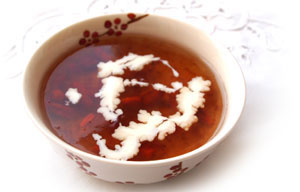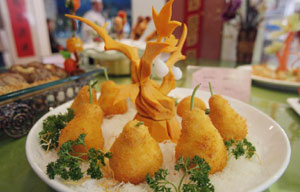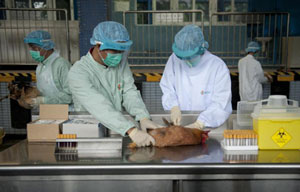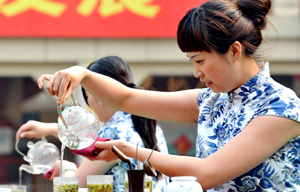

 |
|
Top: Hani red rice is a delicious, nutty, all-natural grain. Above: Red rice is made into noodles. Photos by Pauline D. Loh / China Daily |
The paddy terraces rise from the valleys to the mountaintops, and the lifestyle here has changed little since time immemorial, just like the ancient variety of red rice that has been grown for more than 1,000 years. Pauline D. Loh visits the Red River Valley.
It's called the Honghe Hani and Yi autonomous prefecture, tucked away in a southwestern corner of Yunnan province, almost next to the China-Vietnam border.
The weather here is hot in the valleys, going up to about 40 C in summer, and progressively cooler as you travel the winding roads toward the clouds.
It has a microclimate that depends on the lush vegetation on the mountainsides to trap the moisture rising from the valleys and then helping it condense into rain.
But what is important is that the region is an ecological dream, where the farmers respect nature, and nature, in turn, blesses them with rich soil and abundant water.
This is also where an ancient variety of rice grows, a red grain that is tinged with a deep pink blush, an heirloom variety that is totally organic, and totally in tune with nature.
There is no need to use pesticide or chemical fertilizers.
In this bit of paradise, man and nature has reached perfect harmony, thanks to an age-old respect for every tree and every hill, every stream and every pond.
Quanfu village, not far from the old township of Yuanyang, is a Hani tribal showcase that still clings tenaciously to cultivation of red rice according to nature's calendar. Ducklings released into the terraces when the rice seedlings are planted in May keep the plants pest-free and well fed.
As the ducks grow alongside the paddy, their waste fertilizes the rice, and their foraging among the roots release nutrients into the water, which the plants can then use.
Water buffalos are the sacred cows here, and if you meet an animal or two along the narrow bunds, the two-legged have to give way. It is the Hani way of respecting an animal that works hard at sloughing the fields, and making sure the rice terraces are prepared for the late spring planting.
As the rice plants mature, chickens and their young, pigs and piglets are allowed to roam along the edges of the fields and bunds. Their natural waste, too, feed the paddy.
What about the rice? It is delicious, and it is sad that not enough people have tried it. The best way to describe it is a cross between white rice and wild rice. It is medium-grained, and has a slightly sticky texture. Yet it retains a pleasantly sweet nuttiness that is similar to the more intensely basmati, the Indian rice that grows in the Kashmir Himalayan foothills.
The Hani people love their red rice, and they eat it as it is, make it into rice vermicelli and mill it into a meal that is cooked and set with a little bit of alkali to make "red rice shrimps" and "red rice cakes".
But just as the rest of China is discovering this rare rice variety, a crisis is looming, and it's all about the rural-to-urban diaspora that is threatening so much of China's countryside traditions.
When we visited Quanfu village, we saw some of the terraces without water. It is not because the area is suffering from the three-year drought that has hit the rest of Yunnan province, it is because there was no one to work the land.
"These terraces belong to two old people. Their son has left to work in Kunming," a village elder tells us. The cracks on the field were so symbolic of the cracks in current societal values that have drawn the young and able away from the self-sufficient lifestyle of their forefathers.
Red rice is cheap here, because every family grows its own. The farmers harvest the duck eggs, and the occasional festivity will see a chicken or two slaughtered. On major occasions, a piglet is sacrificed.
For the most part, however, families harvest little fish from the paddy terraces like the slippery loach and even fat tadpoles. The Hani also like dragonfly larvae, which grow in the water and are enjoyed like prawns.
On the bunds separating the terraces, vegetables like water convolvulus, fiddleheads, all sorts of wild herbs like dill and chives, and orchid shoots provide greens for the table. Potatoes are also grown.
Food is more than sufficient, but there is little money for the gadgetry that the young find so essential these days. And so, they are deserting the Hani rice terraces in search of the bright city lights, iPhones, iPads, Wi-Fi gadgets and social networking on the Internet.
This trend is worrying, and threatening.
If no one appreciates the red rice, and they cannot find a market for the grain, the rice terraces will fade away as part of history when the old farmers die.
It will also be an ecological tragedy, and China may lose one of its most precious geographical features, something which photographers are already trying to capture with a desperation borne out of foreknowledge.
In a country plagued by food safety issues and dastardly black sheep producers, the Honghe rice terraces are shining examples of how time-tested agricultural practices must be preserved to counter all that bad press. They also point the way back to how we should eat.
To the credit of Honghe's agricultural authorities, there is already an enlightened push to market red rice to the rest of China, and to promote controlled tourism to the area. These are, at least, baby steps in the right direction.
If you would like to support the Honghe farmers, e-mail me at paulined@chinadaily.com.cn and I will connect you with the agricultural board. In the meantime, here are some recipes to read and enjoy.
Recipe | Hani Red Rice Meatballs
Ingredients (makes about 10 to 15):

500 g minced pork
2 rashers streaky bacon
Half a brown onion, finely minced
1 cup red rice, soaked overnight
1 tsp light soy sauce
1 tsp sesame oil
1 tbsp potato or corn starch
Pepper to taste
Method:
1. Finely chop bacon rashers. (The Hani use smoky salted pork.)
2. Place minced meat, chopped bacon and minced onions into a large bowl and sprinkle the starch. Season with soy sauce, sesame oil and pepper.
3. Mix very well and stir in one direction.
4. Drain the soaked red rice and set aside.
5. Divide the meat mixture into portions and roll them into meatballs. Press red rice evenly over the surface.
6. Place the red rice covered meatballs onto an oiled plate and steam over high heat for 15 minutes.
7. Remove from the heat and pour away any water at the bottom of the plate. Serve hot.
Recipe | Hani Red Rice with Coconut Milk
Ingredients (serves 4 to 6):
2 cups (300 g) red rice
1 cup thick coconut milk
1 tsp salt
1 and a half cup water
Method:
1. Wash the red rice thorough and pick out any natural chuff and grit.
2. Place red rice in a rice cooker and add the coconut milk and water. Mix in the salt and stir well.
3. Cook the rice and fluff with a fork or chopsticks before serving.
Food notes:
This is an excellent way of serving the nutty red rice. The coconut milk adds a subtle fragrance and it goes well as a side dish to any meat. The Hani will serve the rice with a mint and shredded pork salad, with a nice fried duck's egg by the side, sunny-side up.

2013 Chinese New Year |

Hidden dragons, crouching tigers |

Soap beans, silver ears and peach gum |

Special:Winter Solstice |

'Potato festival' kicks off in Shandong |

Mario themed restaurant opens in Tianjin |

HK carries out avian influenza tests on imported chicken |

2013 China Tea Conference kicks off in Zhejiang |